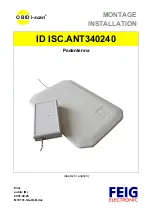
Configuring The Satellite Modem Interface.
9711IMA-70
9-4
9.1.4.3.
Modem I/O – Lock Input - Voltage
Use: The Modem I/O Lock Input Voltage selection defines the nominal voltage range for the
hard lined wire input for indication of Positive Satellite ID (RX Network Lock indication).
Selection Type: Mutually Exclusive Radio Buttons
Options: Voltage 3V, 5V or 12V.
Notes: Modem Type “Custom” must have been selected to allow changes to this setting.
You must refer to your satellite modems manufacturers written specifications for the receive
lock indication voltage range that it provides as an output. The receive logic level itself is
interpreted by the MXP based on the above mentioned Polarity selection (the actual Low versus
Hi polarity trigger is 50% of selected voltage range). Example: You have a satellite modem that
provides a 12VDC output range and Polarity has been set to Low. When the detected voltage is
between 0 to 6Vdc, the MXP would interpret this as a Positive Satellite ID. Voltage between 6.1
and 12Vdc would be interpreted as a failed Positive Satellite ID (because it is High).
If your modem provides a continuity based output (short to ground is Low, and Open is high),
you must set this selection to 12V.
9.1.4.4.
Modem I/O – Lock Input - 12V Pull Up
Use: The Modem I/O Lock Input 12V Pull Up selection defines whether or not to use a built-in
12VDC Pull up resistor for the hard lined wire input for indication of Positive Satellite ID (RX
Network Lock indication). The MXP requires a voltage input for this satellite ID functionality.
If your modem outputs continuity based logic, the pull up circuit (ON) converts the continuity
to voltage. For all voltage based modem outputs, it MUST be set to OFF to prevent false
Positive Sat ID indications (voltage high & higher, but never low).
Selection Type: Mutually Exclusive Radio Buttons
Options: 12V Pull Up Off or On.
Notes: Modem Type “Custom” must have been selected to allow changes to this setting.
If your modem provides a continuity based output (short to ground is Low, and Open is high)
this selection must be set to “ON”. For all voltage based modem outputs, it MUST be set to OFF.
9.1.4.5.
Modem I/O – Block Output – Polarity
Use: The Modem I/O - Block Output selection defines whether or not the MXP will provide a
logic level Low or logic level Hi output when a condition exists that requires muting the IF
transmission of the system. This is known as TX Mute functionality and is a signal from the MXP
to the Satellite Modem (which in turn removes drive to the Block Up Converter mounted on the
antenna assembly). The signal flow for this feature is from the MXP to the Satellite Modem.
Selection Type: Mutually Exclusive Radio Buttons
Options: Polarity Low or Hi.
Notes: Modem Type “Custom” must have been selected to allow changes to this setting.
You must refer to your satellite modems manufacturers written specifications for the input
required to mute the modems output to the BUC. Ascertain whether the input signal must be Hi
or Low logic to mute and whether it is continuity based logic or voltage based.
Example: If your satellite modem requires a Hi logic input (continuity or voltage) to cease
transmissions you must select Hi.
There are numerous compliance laws (FCC and other worldwide entities) that mandate the
ability and/or need to immediately mute transmit on a VSAT system when at least one of
numerous predefined conditions are met. In most cases, these are conditions that ultimately
determine that the system is not accurately pointed to the desired satellite. However there are
some conditions where this may not be true, as is the case of the antenna being pointed at a
pre-defined “Radiation Hazard Zone”, which discussed in detail within another chapter of this
manual, is programmed in as a Blockage Zone, thus the name Block Output.
There may be an area on board the vessel in which crew and/or guests may be in the direct path
of the terminals transmission to the satellite and might possibly be harmed by long term
exposure to the microwave signal. This sector would be described as a blockage zone so that
the transmissions from the antenna would cease when pointed in that area. Similarly a mast or
other structure on the ship, directly in the beam path of the transmission, which would prevent
transmitted signal from reaching the satellite and cause reflections which may degrade the
signal or even be harmful to the antenna. These obstructions would also be described as a
blockage zones. This similar in concept to “sector blanking” a radar array.
EAR Controlled - ECCN EAR99
Summary of Contents for SEA TEL 9711IMA-70
Page 6: ...9711IMA 70 vi This Page Intentionally Left Blank EAR Controlled ECCN EAR99...
Page 10: ...9711IMA 70 Table of Contents x This Page Intentionally Left Blank EAR Controlled ECCN EAR99...
Page 14: ...Introduction 9711IMA 70 1 4 This Page Intentionally Left Blank EAR Controlled ECCN EAR99...
Page 60: ...Setup Azimuth Trim 9711IMA 70 7 2 This Page Intentionally Left Blank EAR Controlled ECCN EAR99...
Page 74: ...Setup Targeting 9711IMA 70 10 4 This Page Intentionally Left Blank EAR Controlled ECCN EAR99...
Page 124: ...Drawings 9711IMA 70 18 2 This Page Intentionally Left Blank EAR Controlled ECCN EAR99...
Page 132: ...EAR Controlled ECCN EAR99...
Page 133: ...EAR Controlled ECCN EAR99...
Page 134: ...EAR Controlled ECCN EAR99...
Page 159: ...EAR Controlled ECCN EAR99...
Page 160: ...EAR Controlled ECCN EAR99...
Page 165: ...EAR Controlled ECCN EAR99...
Page 177: ...EAR Controlled ECCN EAR99...
Page 178: ...EAR Controlled ECCN EAR99...
















































